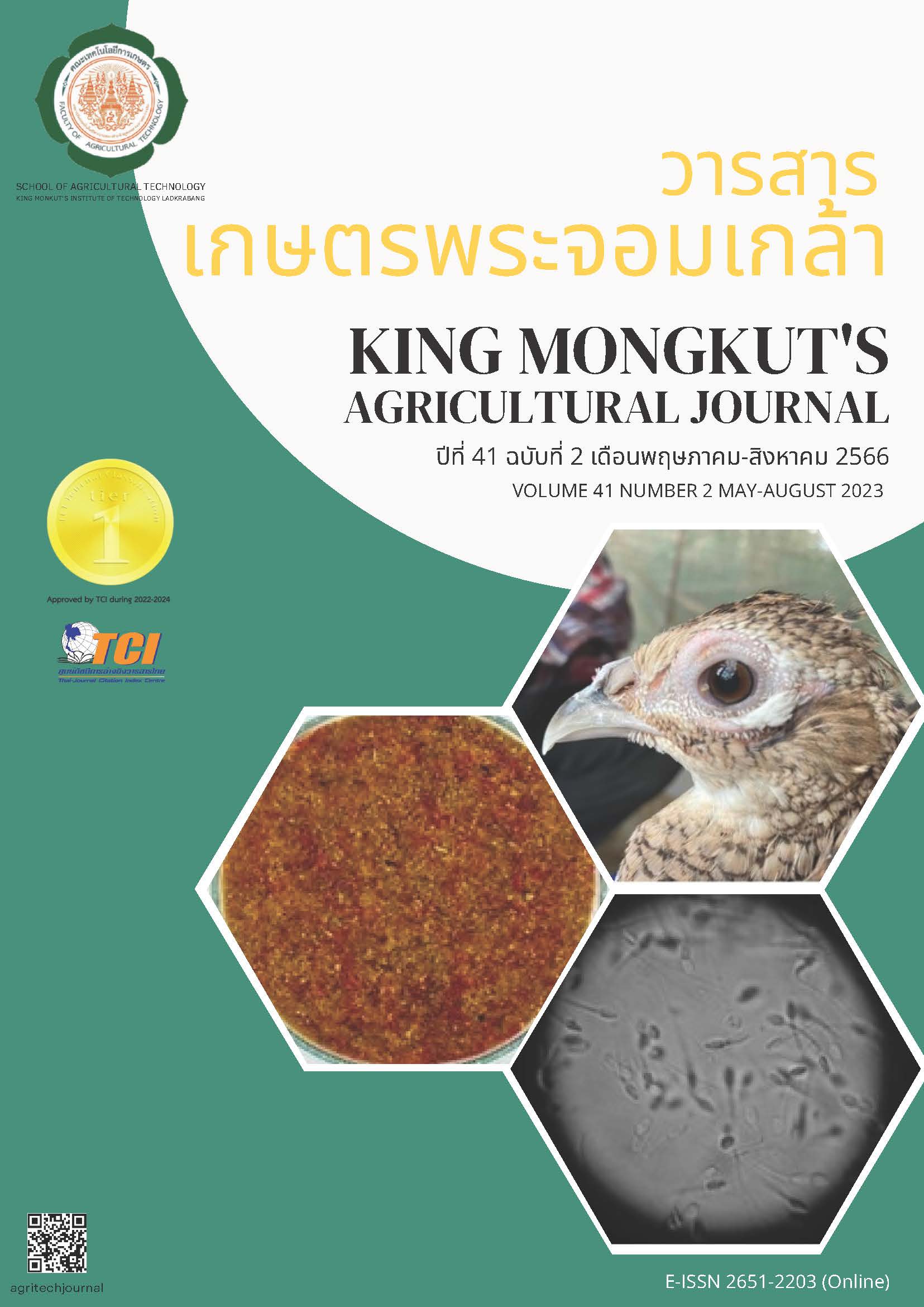แนวทางการพัฒนาสูตรอาหารเลียงผาในสภาพกรงเลี้ยง : กรณีศึกษาองค์ประกอบทางเคมีของอาหาร และปริมาณการกินได้ของเลียงผา (capricornis milneedwardsii) สภาพกรงเลี้ยงในเชียงใหม่ไนท์ซาฟารี
Main Article Content
บทคัดย่อ
การศึกษาครั้งนี้มีวัตถุประสงค์เพื่อศึกษาองค์ประกอบทางเคมีของอาหาร และศึกษาปริมาณการกินได้ของเลียงผาที่เลี้ยงในสภาพกรงเลี้ยงโดยใช้เลียงผาในสำนักงานเชียงใหม่ไนท์ซาฟารี จำนวน 9 ตัว อายุเฉลี่ย 5 ปี น้ำหนักตัวเฉลี่ย 60.33±5 กิโลกรัม ระยะเวลาการทดลอง 90 วัน โดยอาหารที่ใช้เลี้ยงประกอบด้วย กล้วยน้ำว้าดิบ ฝักข้าวโพดหวาน ผักบุ้งจีน ต้นข้าวโพด และหญ้าแพงโกล่าแห้ง สุ่มเก็บตัวอย่างเพื่อทำการวิเคราะห์องค์ประกอบทางเคมี โดยวิธี Proximate analysis และ Van Soest และนำอาหารไปเลี้ยงเลียงผา โดยวางแผนการทดลองแบบสุ่มสมบูรณ์ (CRD) ทำการบันทึกปริมาณการกินได้ (feed intake) เพื่อนำไปคำนวณหาปริมาณการกินได้ของวัตถุแห้ง (dry matter intake) จากการศึกษาครั้งนี้พบว่าฝักข้าวโพดหวานมีปริมาณอินทรียวัตถุสูงกว่าอาหารชนิดอื่นๆ อย่างมีนัยสำคัญทางสถิติ (P<0.001) และหญ้าแพงโกล่าแห้งมีปริมาณโปรตีน และไขมัน ต่ำกว่าอาหารชนิดอื่นๆ อย่างมีนัยสำคัญทางสถิติ (P<0.001) อีกทั้งเมื่อพิจารณาจากปริมาณโภชนะที่เลียงผาได้รับ พบว่า เลียงผามีปริมาณการกินได้ของวัตถุแห้ง อินทรียวัตถุ โปรตีน และเยื่อใย ของต้นข้าวโพดสูงกว่าอาหารชนิดอื่นๆ อย่างมีนัยสำคัญทางสถิติ (P<0.001) ซึ่งเลียงผาสามารถใช้อาหารเพื่อเป็นแหล่งพลังงานและนำไปใช้ประโยชน์ต่อการดำรงชีวิต การเจริญเติบโตได้มากกว่าอาหารชนิดอื่นๆ และยังมีต้นทุนค่าอาหารที่ถูกกว่าอาหารชนิดอื่นๆ อีกด้วย ดังนั้นต้นข้าวโพดเหมาะสมที่จะใช้เป็นแหล่งอาหารในการเลี้ยงเลียงผาในสภาพกรงเลี้ยงเพื่อการอนุรักษ์เลียงผาในประเทศไทยต่อไป
Article Details

อนุญาตภายใต้เงื่อนไข Creative Commons Attribution-NonCommercial-NoDerivatives 4.0 International License.
วารสารเกษตรพระจอมเกล้า
เอกสารอ้างอิง
Allen, M. S. (2000). Effects of diet on short term regulation of feed intake by lactating dairy cattle. Journal of Dairy Science. 83, 1598-1624.
AOAC. (2000). Official Methods of Analysis of the Association of Official Analytical Chemists. 15thed. Washington: Association of Official Analytical Chemists.
Chimchome, V. (1990). Study of food plant species of serow by faeces analysis. Bangkok: Kasetsart University. (in Thai).
Department of Livestock Devlopment. (2008). Nutrient requirements of beef cattle in Thailand. Bangkok: Klungnana vitthaya press. (in Thai).
Devendra, C. & McLeroy, G. B. (1982). Goat and Sheep Production in the Tropics. Intermediate Tropical Agricultural Series. London: Scientific and Technical Publishers Longman.
Dado, R. G. & Allen M. S. (1995). Intake limitation, feeding behavior and rumen function of cow challengewith rumen fill from dietary fiber of inert bulk. Journal of Dairy Science. 78, 118-133.
IUCN. (2008). IUCN Red List of Threatened Species. Retrieved from: www.iucnredlist.org.
Jia, Z. H., Sahlu T., Femandez J. M., Hart S. P. & Teh T. H. (1995). Effects of dietary protein level on performance of Angora and cashmere-producing Spanish goats. Small Ruminant Research. 16, 113-119.
Khrueahong, J. & Ngampongsai, C. (1983). Ecology and some behavioral characteristics of serow (Carpicornis sumatraensis) in captivity. In Proceedings of the 4 th Thailand wildlife seminar. (pp. 276-291). Bangkok: Faculty of Forestry, Kasetsart University. (in Thai).
Rashid, M. (2008). Goats and Their Nutrition. Retrieved from: https://www.gov.mb.ca/agriculture/livestock/goat/pubs/goats-and-their-nutrition.pdf
Sangthong, K., Noosen, P. & Ngampongsai, W. (2022). Effects of dietary protein levels in concentrate on growth performance and nutrient utilization of Thai indigenous male goat. Khon Kaen Agriculture Journal. 50(2), 448-459. (in Thai).
Steel, R. G. & Torrie, J. H. (1980). Principles and procedures of statistics. New York: McGraw Hill Books.
Sultan, S., Kundu, S. S., Negi, A. S., & Pachouri, V. C. (2010). Performance of growing kids on rations with Lablab (Lablab purpureus) grains as protein source. Livestock Research for Rural Development. 22(5), 93.
Suntharalingram, S. & Ravindran G. (1993). Physical and biochemical properties of green banana flour. Plant Foods for Human Nutrition. 43(1), 19-27.
Sutham, R. (2014). Evaluation of Nutritive Values and Digestibility of Feeds for Captive Serow (Capricornis sumatraensis). Master of Science (Agriculture) Animal Science. Chiang Mai University. (in Thai).
Van Soest, P. J., Robertson, J. B., & Lewis, B. A. (1991). Methods for dietary fiber, neutral detergent fiber, and nonstarch polysaccharides in relation to animal nutrition. Journal of Dairy Science. 74(10), 3583-3597.
Yamamoto, Y., Atoji, Y., Agungpriyono, S., & Suzuki, Y. (1998). Morphological study of the forestomach of the Japanese serow (Capricornis crispus). Anatomia Histologia Embryologia. 27, 73-81.


